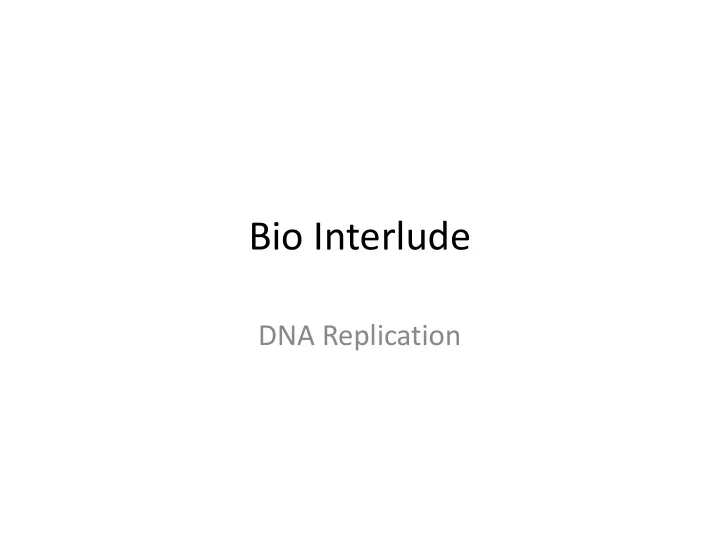

Bio Interlude DNA Replication
DNA Replication: Basics G T T A A G T T T C 5’ 3’ G ACGAT 3’ 5’ 3’ 5’ C A A G G T C A C A
Issues & Complications, I 1st ~10 nt’s added are called the primer In simple model, DNA pol has 2 jobs: prime & extend Priming is error-prone So, specialized primase primase does the priming; pol primer specialized for fast, 3’ 5’ accurate extension pol starts here Still doesn’t solve the accuracy problem (hint: primase makes an RNA primer)
Issue 2: Rep Forks & Helices “Replication Fork”: DNA double helix is progressively unwound by a DNA helicase, 5’ and both resulting single strands are duplicated DNA polymerase synthesizes new strand 5’ - 3’ > 3’(reading its template strand 3’ -> 5’) 5’ That means on one (the “leading”) strand, DNA pol is chasing/pushing the replication 3’ fork But on the other “lagging” strand, DNA pol is running away from it.
Issue 3: Fragments 3’ 5’ Lagging strand gets a series of “Okazaki fragments” of primer DNA (~200nt in eukaryotes) pol starts here following each primer The RNA primers are later removed by a primer Okazaki primer nuclease and DNA pol fills gaps (more accurate than primase; primed by DNA from adjacent Okazaki frag Fragments joined by ligase
Issue 4: Coord of Leading/Lagging Alberts et al., Mol. Biol. of the Cell, 3rd ed, p258
Very Nice DNA Repl. Animation https://www.youtube.com/watch?v=yqESR7E4b_8 (Replication starts at about 1:40)
Issue 5: Twirls & Tangles Unwinding helix (~10 nucleotides per turn) would cause stress. 5’ Topoisomerase I cuts DNA backbone 5’ on one strand, allowing it to spin about the remaining bond, relieving 3’ 3’ stress Topoisomerase II can cut & rejoin both strands, after allowing another double strand to pass through the gap, de- tangling it.
Issue 6: Proofreading Error rate of pol itself is ~10 -4 , but overall rate is ≈ 10 -8 – 10 -9 , due to proofreading & repair, e.g. pol itself can back up & cut off a mismatched base if one happens to be inserted priming the new strand is hard to do accurately, hence RNA primers, later removed & replaced other enzymes scan helix for “bulges” caused by base mismatch, figure out which strand is original, cut away new (faulty) copy; DNA pol fills gap which strand is original? Bacteria: “methylate” some A’s, eventually. Euks: strand nicking
Replication Summary Speed: 50 (eukaryotes) to 500 (prokaryotes) bp/sec Accuracy: 1 error per 10 9 bp Complex & highly optimized Highly similar across all living cells More info: Alberts et al., Mol. Biol. of the Cell
Recommend
More recommend